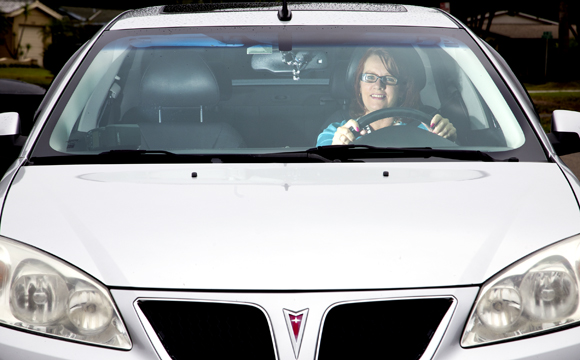Tired of driving? Ride-hailing services ready to help transform Tampa Bay transportation scene
Ride-hailing services like Uber and Lyft increasingly offer alternatives for getting around town to Tampa Bay area residents tired of driving themselves or depending on traditional cab companies.

Ride-hailing services like Uber and Lyft increasingly offer alternatives for getting around town to Tampa Bay area residents tired of driving themselves or depending on traditional cab companies.
As part of today’s larger sharing economy, the growing on-demand transportation network is rising in popularity here and in cities throughout the United States. In addition to providing locals with cheap rides, ride-hailing companies offer people who own their own cars the opportunity to become drivers and earn quick cash.
But unlike cab companies, which generally employ full-time drivers with benefits, Uber and Lyft tap a virtually unlimited resource of ordinary citizens as drivers willing to chauffeur strangers in their private vehicles. Concerns about licensing, insurance and additional government regulations are being debated on the local and state level in Hillsborough County and Florida, and in several other communities.
Drivers share experiences, insights
Darlene, who asked to be identified by only her first name after expressing concerns about risking her personal automobile insurance coverage, first hit the road with Uber in September 2014 and went full-time with the transportation network company in January 2015.
Having logged nearly 2,000 trips, she says, “many moving, interesting irritating, happy moments have occurred.” Her longest ride? A 125-mile one-way fare that started at last year’s Gasparilla parade. “I picked [the guest] up on Kennedy Boulevard and dropped off nearly at Titusville. I made $334 off that one trip.”
She has heard couples belting their hearts out to Journey’s 1982 power ballad “Don’t Stop Believing,” endured drunk guys putting their hands on her face in a game of “peek-a-boo,” experienced language barriers, and even shuffled a bride and groom off to their wedding after-party to Jackson’s Bistro on Harbour Island.
“I’ve made wonderful connections through this ‘job,’ and it’s really an honor to have the freedom and flexibility. I also believe in positive energy, and I am certain we all cross paths when we’re supposed to.”
Gabriel Sanchez, a risk adviser for a Tampa accounting firm, spent about a year driving passengers around in his car, first under the Lyft banner and then later for Uber.
“I started with Lyft in June 2014,” he says. “I saw the pink mustache on USF’s campus one day,” says the 24-year-old of Lyft’s defining trademark that drivers strap to the front of their cars. “I Googled it, saw the opportunity, signed up, and was approved within a week after a personality interview.
“My first ride I was very nervous,” he admits. “But, after a few, I got the hang of it.” He says there are Facebook pages called “Lyft Lounges,” which are closed groups where Lyft drivers can fraternize with each other, share stories and receive support. “It was like a little family, everyone always wanting to help each other out.”
Sanchez says his passengers took him throughout Tampa, and some rides even took him into St. Petersburg.
“I learned so much about the Tampa roads and routes doing this and enjoyed every minute of it.”
Spending 10 hours over the course of two days a week, Sanchez was compelled to join the realm of transportation network companies “because there was a need in the market for a friendly person who would give me an affordable ride.”
While he focuses his time on his accounting job these days, he still gets around town as a passenger in Uber and Lyft vehicles.
“I feel much safer and the people are much nicer,” he opines. He also offers these personal insights: “If you prefer a silent ride or prefer to work or not be disturbed, I recommend you take an Uber. If you want a more lively experience and a friendly conversation (only if you want it), then Lyft is preferred.”
Customer compares Uber to cabs
Jared Cordes, a writer who works for a Tampa marketing firm, says he asks for a ride from Uber once or twice a month in St. Petersburg via an app on his smartphone. “My friends and I have gotten in the habit of taking [an Uber ride] every time we go downtown. Obviously, it’s way safer and smarter than drinking and driving, and it lets everyone have a good time without worrying about getting home.”
Cordes says he believes Uber offers many advantages over conventional taxicabs. “It’s such a hassle to call a dispatch center and try to coordinate a pickup,” he says. He prefers using apps. “Hit a button, and a car is sent to your location. No trying to explain where you are or talking to anyone — plus you can use [the app] to estimate fares.”
Cordes, 30, says that in his experience with cab companies, “they get the address wrong or the wait is super long, or some other problem arises.”
With Uber, “one of our group just opens the app and usually a car is in my driveway within 10 minutes.” He adds, “the trips are significantly cheaper than with traditional taxicabs. From my house it costs around $10 (for an Uber ride) – in a taxi, it’s usually around $25.”
While Cordes sings praises about Uber and Lyft, he thinks there are areas where both transportation network services could improve, including, “the affordability and ease of use.” Cordes continues, “the drivers can be a mixed bag because they’re just normal people. I’ve had people who had been awesome and made the trip entertaining, and I’ve had the weirdos who won’t stop talking, which makes me miss a ‘boring’ cabbie.”
Room for improvement
Hillsborough County Commissioner Victor Crist says he has used Uber and Lyft for rides, and he wants to see them succeed in the Bay Area.
“I want Uber and Lyft in the Tampa market and enjoy using them in other markets, where they are in operation,” he says. However, he believes something needs to be done to regulate Uber and Lyft for the safety of passengers and drivers and to improve fairness of competition between ride-hailing services and traditional taxi companies.
A few of the major sticking points have to do with background checks, vehicle certification, operation fees and insurance as they relate to existing regulations for cab companies in Florida.
“In larger markets such as New York City, Chicago and Los Angeles, Uber and Lyft comply with all laws and regulations,” Crist says. These stipulations entail everything from detailed and ongoing background checks on the drivers, inspections on vehicles that are older than three years of age or have more than 36,000 miles, insurance coverage for all passengers and drivers and multiple liabilities, and compliance with Americans with Disabilities Act (ADA) regulations.
The regulation scene throughout the Greater Tampa Bay Area resembles a patchwork. Until September 2015, Hillsborough County had been issuing citations against Uber and Lyft drivers as a way of punishing illegally operating ride-hailing services until existing regulations were met by the fledgling transportation companies. At the time, the county’s stance was that it was legal for locals to use Uber and Lyft, but illegal for drivers to operate without meeting the commercial fare regulations in place.
Meanwhile, the Sarasota County Commission abandoned seeking regulations for companies such as Uber and Lyft by deregulating both ride-hailing services and taxi companies.
“The reason Uber and Lyft cost less locally than cabs is because the taxi companies are paying for licensing, inspections and other mandatory matters whereas Uber and Lyft aren’t,” explains Crist. “If the Uber and Lyft companies in Florida were compliant with the same codes taxi cabs are, they would cost more. The first thing legislation needs to do is require insurance companies to offer coverage to riders for ride-hailing. Other states have, and Florida has to.”
Crist is chair of the Public Transportation Commission Board, which pitched a bill in the fall of 2015 that covers four areas of regulation. These include:
- Each driver must undergo background checks already required of most public transportation service vehicles.
- Each driver must have personal and liability insurance that covers the passengers, pedestrians and vehicle during its business use.
- The legislation requires accommodations for the Americans with Disabilities Act.
- Each vehicle must have annual safety inspections.
Crist, vowing to see a resolution on the matter by the end of 2016, calls for a solution locally, if not on a statewide basis, so Hillsborough County can focus on other transportation issues that also need attention. “Let’s get standards in place so we can move on.”
Protecting the public
Lyft spokesperson Danyelle Ludwig agrees that new laws need to be crafted to address the types of services her company and others like it offer.
“Lyft is committed to working with Tampa to craft a ride-hailing policy that both protects the public safety and welcomes innovative transportation options. Ultimately, a state law will provide the most consistency across cities and suburbs in Florida, so that drivers can operate from Tampa to neighboring towns like St. Petersburg without running into regulatory barriers.”
Louis Minardi, president of Yellow Cab Company in Tampa, has been watching the debates over regulations play out on the streets of the Bay Area.
“The main issue,” as he sees it, “has been insurance.” Under current law, operators of commercial vehicles in Florida must have (often expensive) policies that cover drivers, passengers, properties and other liabilities. While operators at the Yellow Cab Company are paying huge premiums for the mandatory insurance policies, Uber and Lyft drivers are shuffling passengers around town on private insurance plans that are insufficient for commercial ride-hailing.
“If you use personal insurance, you can’t drive a commercial vehicle,” Minardi says. At this time, all for-hire insurance providers must be a member of the Florida Insurance Guaranty Association (FIGA), which protects consumers and taxpayers from unpaid claims.
Insurance isn’t the only area where Minardi sees friction. He’s also concerned about the safety of passengers using transportation network companies. He sees a trend of what he calls “gypsy drivers” — those who he says claim to drive for a recognizable ride-hailing service but are in fact completely independent and possibly rogue.
“They’ll offer a ride, claiming to be a member of Uber or Lyft, but aren’t with any service and are simply waiting to get you in the car to take you somewhere and rob you. There needs to be an identifying mark so you know who’s driving and that they’re in a certified car.”
Minardi, who is also president of the Florida Taxicab Association, says, “if we don’t have enforcement to back up the laws, we have nothing.” Regardless of what policy or level of enforcement is set forth, he says this: “I want to see the laws work for everybody.”
In the meantime, Minardi is concerned about the welfare of his employees in the wake of presently unregulated competition.
“I’m worried about my drivers. They pay for insurance, certifications, and invest a lot of their time and money into being cab drivers. Many of our drivers have been with us 10, 15, 20 years or more and make a full-time career out of it.”
At the end of the day, Minardi wants people to remember that taxicab services are safe and rates are consistent. Laughing, he adds, “we have apps, too!”













